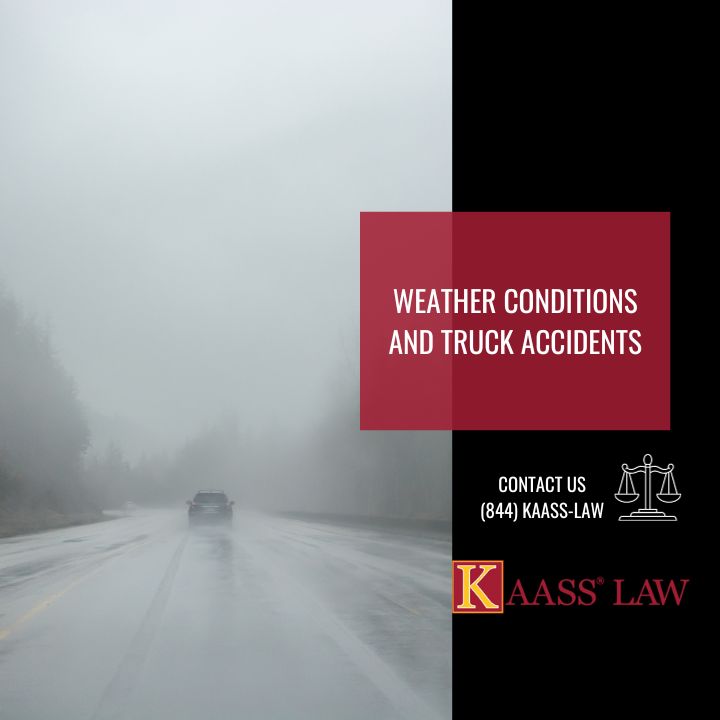Driving a truck is a demanding job that requires skill, attention, and adaptability. One of the most significant challenges for truck drivers is navigating through various weather conditions. Weather-related accidents are unfortunately common, as well as understanding how different weather patterns can affect road safety is crucial for every truck driver. Thus, in this blog, we’ll explore how weather conditions contribute to truck accidents and provide valuable tips for safe driving.
1.Rain
Rainy weather is a common hazard on the roads, and it significantly impacts driving conditions. Hence, the road surface becomes slick, reducing traction and increasing the risk of skidding or hydroplaning. Poor visibility is another major concern, making it harder to see other vehicles, road signs, and potential obstacles.
Safety Tips:
- Lower your velocity: To enable longer stopping distances and improved vehicle control, slow down.
- Boost the distance after: To allow for unexpected pauses, maintain a safe gap between your truck and the car in front of you.
- Employ headlights: Even in the day, you can improve visibility by turning on your headlights.
- Steer clear of abrupt movements. Control can be maintained by applying smooth, progressive steering, braking, and acceleration.
2. Snow and Ice
Winter weather brings a host of challenges for truck drivers, including snow, ice, and freezing temperatures. For example, snow and ice accumulation on the road can lead to treacherous driving conditions. Reduced traction, decreased visibility, and the potential for black ice all contribute to the elevated risk of accidents.
Safety Tips:
- Equip your truck with snow tires or chains: Proper tires designed for winter conditions can provide better traction on icy or snowy roads.
- Clear snow and ice from your truck: Ensure all windows, lights, and mirrors are clear of snow and ice before hitting the road.
- Brake carefully: Use gentle, controlled pressure on the brakes to avoid skidding. Consider using engine braking to slow down on icy roads.
- Maintain a slow and steady pace: Avoid sudden movements, including accelerating, braking, and steering. Smooth and deliberate actions are key.
3.Fog
Fog is a notorious weather condition that severely impairs visibility on the road. In dense fog, it becomes challenging to see more than a few feet ahead, making it difficult to react to sudden changes in traffic.
Safety Tips:
- Use low-beam headlights: High beams can reflect off the fog and make visibility even worse whereas low beams provide better illumination.
- Reduce your speed: Slow down to a safe, manageable speed, and be prepared to stop suddenly if necessary.
- Use hazard lights if needed: In extremely low visibility conditions, it may be appropriate to use hazard lights to signal your presence to other drivers.
- Stay in your lane: Avoid making sudden lane changes and stay centered in your lane.
4. Wind
Strong winds can be a significant challenge for truck drivers, especially on open highways or in areas prone to gusty conditions. High winds can cause a truck to sway or even tip over, especially if it’s empty or carrying a light load.
Safety Tips:
- Be alert to wind warnings: Pay attention to weather reports and road signs indicating strong winds in the area.
- Maintain a firm grip on the steering wheel: Keep both hands on the wheel to maintain control of your truck, especially in gusty conditions.
- Reduce speed: Slow down to reduce the impact of gusts on your vehicle.
- Consider pulling over: In extreme wind conditions, consider finding a safe place to pull over and wait for the weather to improve.
Contact an Attorney
Navigating through challenging weather conditions is an integral part of a truck driver’s job. By understanding how different weather patterns can contribute to accidents, drivers can take proactive steps to enhance their safety. Remember to adjust your driving techniques according to the weather, stay vigilant, and prioritize safety above all else. Safe driving not only protects you but also ensures the well-being of fellow road users.
In addition, view our other practices through this website.

